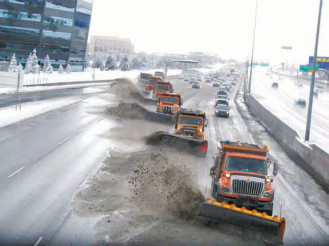 As recently as the ’90s, wintry Colorado drives were quite perilous. Many mountain roadbeds stayed caked in snow and ice for weeks or more, despite plowing. In contrast—today snow is cleared quickly from roads. We think nothing of cruising through mountain passes mere hours after storms hit. In part that’s because Colorado’s street scientists deploy a fine-tuned array of salty substances to keep roads from becoming automotive skating rinks.
As recently as the ’90s, wintry Colorado drives were quite perilous. Many mountain roadbeds stayed caked in snow and ice for weeks or more, despite plowing. In contrast—today snow is cleared quickly from roads. We think nothing of cruising through mountain passes mere hours after storms hit. In part that’s because Colorado’s street scientists deploy a fine-tuned array of salty substances to keep roads from becoming automotive skating rinks.
What are these compounds, how do they work, and what are their impacts?
Solid salts, brine, and traction sand are the most common tools. Their key ingredients are naturally occurring minerals that lower the freezing point of water. Just like the alcohol that’s in wiper fluid, these minerals prevent ice from forming and slice like a hot butter knife through existing ice.
Solid salts are typically a blend of three “chloride” minerals, named after the chlorine ion each possesses. They’re dominated by bischofite, also known as magnesium or “mag” chloride. They also contain some halite, a.k.a. table salt or sodium chloride, and sylvite, a.k.a. potassium chloride. Such salts are mined in Utah from Jurassic (165 million-year-old) rocks that formed as an ancient Persian Gulf-like sea dried up. As the water evaporated, it left its dissolved sea salts behind.

To avoid dangerous, slick roads, Colorado deploys snow plows that spray salty chemicals. What are these compounds, how do they work, and what are their impacts? Photo courtesy of CDOT
Road brine is a mag chloride-rich liquid that also contains a skootch of corrosion inhibitor. Some of this mag chloride comes from giant man-made ponds of water that are evaporated on the edges of Utah’s Great Salt Lake. In winter, brine is sprayed on the road as a storm commences to help break snow’s hold on the road and allow plows to remove the snow. Sometimes it’s used to moisturize traction sand, to help the sand to stick to the road rather than bounce off or become airborne as it’s being spread from the back of a truck. In summer, mag chloride brine is applied to some dirt roads to help reduce dust and harden the roadbed. It’s hygroscopic, so in warmer weather it sucks water vapor from the air and acts like a glue to hold the road’s sand and gravel particles together.
Traction sand is usually mixed with brine, or with a small amount of solid salt. The solid salt prevents damp sand from freezing into clumps and helps it flow smoothly into a sand-truck’s hopper and distributor. Our sand is mined from ancient riverbeds or volcanic cinder cones. Traction sand works best when it becomes half-way embedded in the ice/snow that mantles the roadbed, thus forming a sandpapery texture that inhibits wheels from slipping.
So what are the downsides?
For human health, mag chloride is not a major danger—it’s actually used as a mineral supplement, and you may have even used it as a bath salt. And sodium chloride? You can find bighorns licking it off the side of I-70.
But on metal, all of these substances catalyze corrosion. Especially if you don’t wash them off your car. To alleviate mag chloride’s corrosive impact, utilities regularly rinse it off roadside powerline equipment, and highway agencies power-wash it off roadside posts and signage.
What about the roads? These compounds speed roadbed breakdown, because the dissolved salts weep into cracks and pores in the pavement, where they undermine the integrity of its cement, tar, and/or aggregate (i.e., its itty-bitty rocks). The water that freezes and expands in the roadbed exacerbates these salt-driven effects, causing popouts, flaking, and scaling of the road’s surface.
In high concentrations, none of these compounds are particularly good for roadside vegetation, soils, animals, or aquatic communities. Although concentrations are generally high next to roads, they generally diminish within yards to tens of yards away from roadways; exceptions occur when wind transports salty spray farther afoot.
Road treatments are applied more judiciously today than ever before, with strategic focus on challenging areas like shady inclines, intersections, and susceptible bridges. The goal is to make the road safe but minimize the salt’s impact to flora and fauna. In many of the state’s urban centers, solid treatments are removed by street sweepers within days of a storm’s passage. On high-traveled corridors, they are removed from the road and adjacent settling ponds each spring.
Each year Colorado agencies apply over 250,000 tons of salt and nearly 15 million gallons of brine to our roads; the materials alone cost tens of millions of dollars. These compounds, together with other snow-fighting strategies, save lives, reduce injuries and property damage, and amplify the state’s economy through fostering predictable mobility for people and goods. Thus their positive impact is immense, but not without known tradeoffs.
James Hagadorn, Ph.D., is a scientist at the Denver Museum of Nature & Science. Suggestions and comments welcome at jwhagadorn@dmns.org.




0 Comments